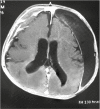Outcome Analysis of Ventriculoperitoneal Shunt Surgery in Pediatric Hydrocephalus
- PMID: 30090131
- PMCID: PMC6057192
- DOI: 10.4103/jpn.JPN_29_18
Outcome Analysis of Ventriculoperitoneal Shunt Surgery in Pediatric Hydrocephalus
Abstract
Aim: To study the clinical outcome of shunt surgeries in children with hydrocephalus and evaluate the risk factors for ventriculoperitoneal (VP) shunt failure.
Materials and methods: Patients who underwent VP shunt surgery for hydrocephalus were included. Medical charts, operative reports, imaging studies, and clinical follow-up evaluations were reviewed and analyzed retrospectively.
Results: A total of 137 patients with the average age of 20.7 months, range from 1.5 months to 8.5 years at the time of VP shunt surgery were included. The incidence of overall shunt complications was 35.76%; incidence of shunt revision was 27%, shunt blockade 45.94%, shunt infection 16.21%, shunt migration 10.81%, and shunt malfunction due to abdominal pseudocyst 10.81%. The mortality rate was 5.10%. The shunt revisions in the first 6 months after shunt placement was observed in n = 9 (24%). Hydrocephalus was associated with post-tubercular meningitis and intraventricular hemorrhage (IVH) in shunt placement was associated with multiple shunt revisions (n = 13, 35.13%) (n = 5, 45.4%), respectively.
Conclusion: The findings of this study indicate that etiology of hydrocephalus, were associated with the shunt survival. Further prospective controlled studies are required to address the observed associations.
Keywords: Complications; hydrocephalus; ventriculoperitoneal shunt.
Conflict of interest statement
There are no conflicts of interest.
Figures







References
-
- Sgouros S, Malluci C, Walsh AR, Hockley AD. Long-term complications of hydrocephalus. Pediatr Neurosurg. 1995;23:127–32. - PubMed
-
- Reddy GK, Bollam P, Caldito G. Long-term outcomes of ventriculoperitoneal shunt surgery in patients with hydrocephalus. World Neurosurg. 2014;81:404–10. - PubMed
-
- Stone JJ, Walker CT, Jacobson M, Phillips V, Silberstein HJ. Revision rate of pediatric ventriculoperitoneal shunts after 15 years. J Neurosurg Pediatr. 2013;11:15–9. - PubMed
-
- Crowley RW, Dumont AS, Asthagiri AR, Torner JC, Medel R, Jane JA, Jr, et al. Intraoperative ultrasound guidance for the placement of permanent ventricular cerebrospinal fluid shunt catheters: a single-center historical cohort study. World Neurosurg. 2014;81:397–403. - PubMed
LinkOut - more resources
Full Text Sources
Other Literature Sources

